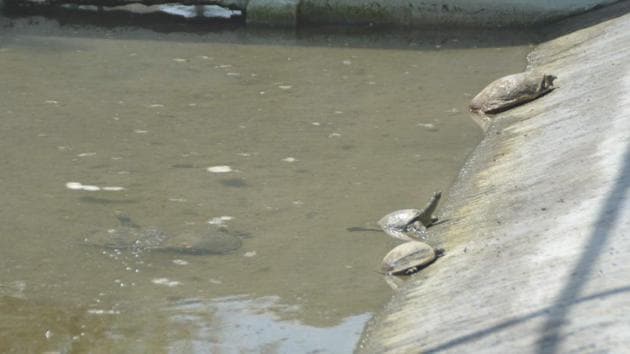Digest this: Non-veg turtles to help in Ganga cleaning!
The Forest department is planning to release around 500 non-vegetarian turtles in the river once they come of age.
The Clean Ganga Mission now has a saviour -- the seemingly nondescript, harmless non-vegetarian Indian turtle!

Hailing from the Chambal river, these non-vegetarian members of the reptile family—flapshell turtle (Lissemys punctata) and softshell turtle play a very crucial role in eating organic wastes, including burnt and half burnt corpses, animal carcasses that are often dumped into the Ganga.
Their vegetarian counterpart— narrow headed softshell turtle and black pond turtle also play an important role in cleaning the Ganga by feeding on flowers and leaves dumped in the river.
Realising the importance of these saviours, the forest department is planning to release around 500 non-vegetarian turtles in the river once they come of age. At present these hatchlings are being bred and raised at the Tortoise Rehabilitation Centre, Sarnath in Varanasi.
“Carnivorous turtles are found in plenty in Chambal area. Their eggs were brought in 2015. Around a year ago, turtle babies (hatchlings) came out. These babies are growing well under natural climatic conditions maintained in and around the hatching ponds have four-foot wide sand strip around as turtle babies like to dig pits and hole up there,” said ranger at forest department SK Singh who also heads the rehabilitation centre.
Turtles
Indian turtles, including flapshell turtle (Lissemys punctata) and softshell turtle are non-vegetarian. They play a very crucial role in doing away with organic wastes, including animal carcass and half burnt bodies often dumped in the Ganga.
Narrow headed softshell turtle and black pond turtle are vegetarian. Herbivorous tortoises are equally important as they feed upon many types of algae that grow at the river bottom along with flowers, leaves dumped in the river.
Water is sprinkled many times to maintain temperature of the sand that is suitable for turtles. Many hatchlings can be seen sitting at the pond’s bank. As soon as these babies attain the right age they will be released in the Ganga.
In the past too, the centre reared and released turtles in the river. But the number of vegetarian turtles outnumbered their non-vegetarian counterparts.
Speaking on the issue Singh said, “Carnivorous or non-vegetarian turtles are a very crucial part of aquatic life in Ganga since they feed upon the burnt and half burnt corpses that are immersed in the river that add to the pollution level of the national river.” He further said, the turtles also feed upon animal carcasses too and have been playing a crucial role in maintaining cleanliness of the Ganga for eternity.
The growing pollution in the river spelt doom for both carnivorous and herbivorous turtles. Hence, the Tortoise Rehabilitation cum Breeding Centre, Sarnath came up under Ganga Action plan in 1987.
During 1987-1992, the forest department authorities brought 55,690 turtle eggs to the Sarnath breeding centre from Chambal river. Of these, 30,091 hatched and were reared at the ponds in the centre. Around 28,920 turtles were released in the river after they reached an appropriate age.
Likewise, in 2005-2006, around 5000 eggs were brought from the Chambal river, of which 3297 turtles hatched and only 1,549 reached the right age who were released in the Ganga. In 2016, around 1000 turtles were released in the river.
Singh claims that altogether around 50,000 turtles including 10,000 non-vegetarian ones were released in the Ganga to maintain balance among aquatic life in the river. He further said that soon a census of aquatic life in Ganga would also begin.





